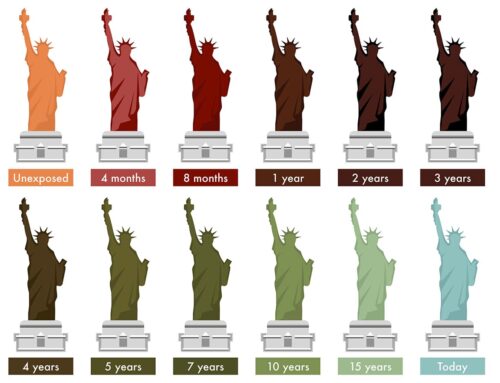If we talk about bare board (or PCB) manufacturing 2 IPC documents are commonly used.
The one that is best known throughout the electronics industry is the IPC-A-600. The A in the designation tells us that these are Acceptance Criteria, the official title being Acceptability of Printed Boards.
If we look at the bare board manufacturing process we can identify the actual production stages and the inspection stages. Before the boards leave the factory and are send to the customers a final inspection has to be done. In many board shops it is here where the IPC-A-600 is used. The actual produced board is compared with the criteria from the IPC-A-600.
This document is based on two different types of inspection. The bare boards to be delivered are inspected visually by means of magnifiers or microscopes. This is to determine the acceptability of the externally observable characteristics.
Furthermore internally observable characteristics are inspected by means of special test coupons to check and assure process stability. Since these are destructive inspection methods they are not performed on all bare boards that are to be delivered.
The vast amount of pictures help the user of the IPC-A-600 to better understand the criteria by providing pictorial information on the topics addressed in this standard.
Some topics from IPC-A-600 that are inspected on PCB level are Solder Coatings, Holes, both Plated-Through and Unsupported, Printed Contacts, Marking, Solder Mask, Pattern Definition.
The test coupons might be inspected for issues like Laminate Voids, Delamination, Smear Removal, Conductor Thickness, both for External as well as Internal Layers, Layer-to-Layer Spacing, Cracks, Annular Ring, etcetera.
In the latest Revision of IPC-A-600 there is also information to be found on Microvia’s, unfilled and copper filled and Copper Wrap Plating.
One of its chapters deals with inspection criteria for Flexible and Rigid-Flex Printed Boards as well as Metal Core Printed Boards. In the last chapter general handling considerations are discussed and the cleanliness and solderability tests which have to be performed.
In many cases the procurement documentation that is used when ordering bare boards specifies the IPC-A-600 as the document of choice for inspection.
The other document is the IPC-6012. Actually this is one of a series of documents, also called the Qualification and Performance Specifications for Printed Boards. At the basis of this series is the IPC-6011 standard, in here we find definitions for the product classes, and general requirements for instance on documentation, qualification assessment, quality assurance etcetera.
The IPC-6012 is the document that contains the Qualification and Performance Specifications for Rigid Printed Boards. Other standards in this series are IPC-6013, IPC-6015, IPC-6017 and IPC-6018.
Topics in this IPC-6012 document are: Material requirements, Visual inspection requirements, Solder mask requirements, Electrical requirements and electrical tests to be performed, Cleanliness requirements and the applicable tests. Also a variety of special requirements that might be specified by contract by the customer are listed and described. Also definitions and requirements with regard to rework and repair are to be found. One chapter concentrates on Quality Assurance Provisions.
Even though the IPC-A-600 contains the criteria and visual interpretation for the inspection of microsections the IPC-6012 goes a step further and into issues like the frequency of microsections to be performed based on lot size and performance class(*).
The IPC-6012 also addresses the minimal thicknesses of final finishes and copper plating in the through-holes and via’s. In general one might say that the dimensions and tolerances commonly used in circuit board manufacturing are implemented in numerous tables.
Catering for the electronics industry for space applications is the addendum to this general IPC-6012E, the IPC-6012ES document, providing specific criteria for this area. Another addendum document to this IPC-6012E is the IPC-6012EM, in which we find specific criteria for bare boards for medical applications. Specific automotive application considerations can be found in the IPC-6012DA, which is based on the former version of the IPC-6012. All addendums built up on the general IPC-6012 providing typically used criteria for these areas.
If you question yourself if you should use the IPC-A-600 or the IPC-6012, then the question should be what application do you want to use it for. If it would be purely to inspect (either the entire board visually or by automatic equipment [AOI] or the microsections from the test coupons) then the IPC-A-600 might be the document of choice, especially since this standard focusses on the criteria and provides a lot of pictorial examples. Inspections like this might be performed during the board manufacturing process steps, as a final inspection at the board shop or as an incoming inspection at the assembly plant or EMS.
For more information regarding the actual processes and materials used at the production stages and for in depth information on the applicable tests to be performed for quality assurance the IPC-6012 is the best if rigid printed circuit boards are involved. These can be single-sided boards, multi-layers, HDI boards, boards with integrated passive components and metal core boards.
It is the document of choice for process engineers and purchasers at printed circuit manufacturers, but designers as well as assembly process engineers at the EMS or OEM might benefit greatly from it.
If you consider using either of the above mentioned documents it might be a good idea to learn all the ins- and outs by attending an IPC certification training based on them. These certification trainings are provided by PIEK on both documents and will increase your knowledge level. Furthermore training will help you in using the criteria correctly and avoid misinterpretation, which might save time and money. Profit from the extensive experience the PIEK trainers have on the use of these documents in daily practice and avoid the pitfalls in daily life caused by misinterpretation.






